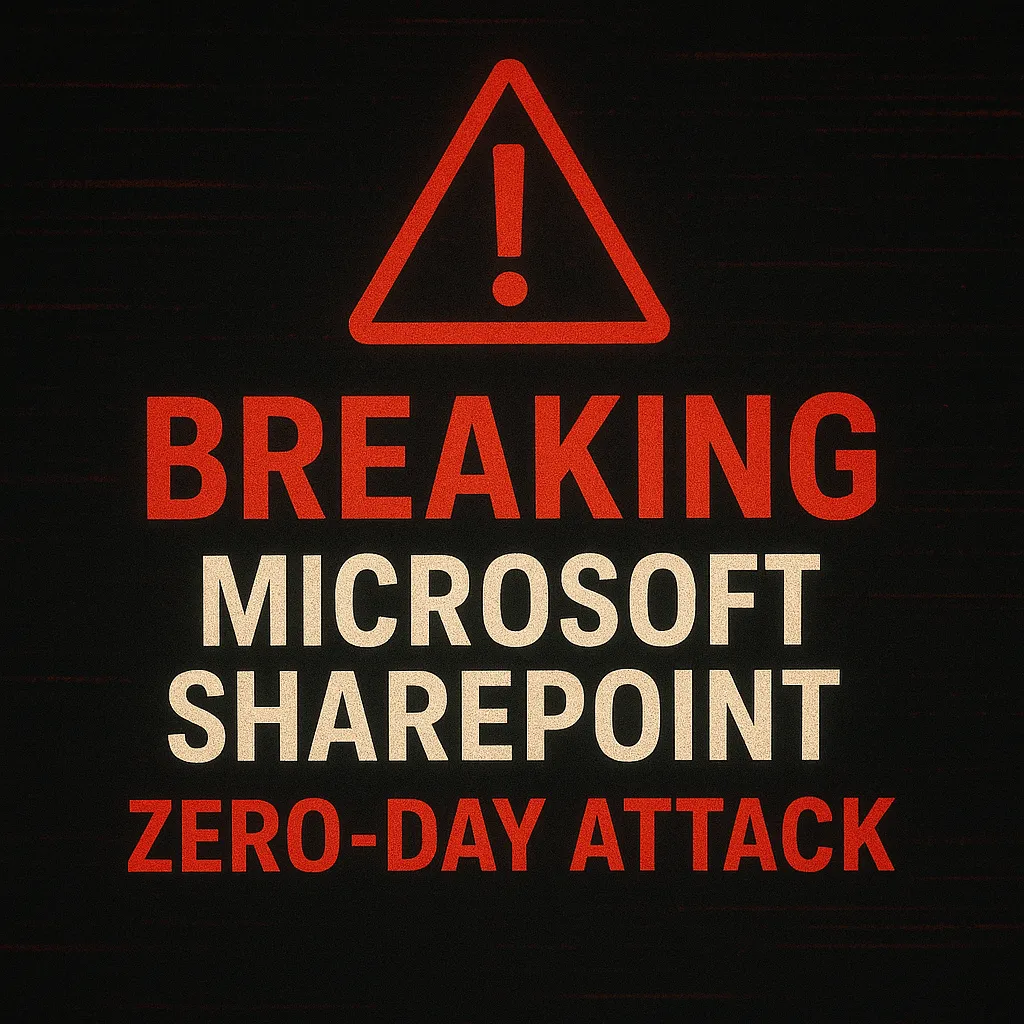
BREAKING: Microsoft SharePoint Zero-Day Attack - The Most Dangerous Cyber Threat Right Now
🚨 BREAKING: Microsoft SharePoint Zero-Day Attack - The Most Dangerous Cyber Threat Right Now
Blog Post Details for GoHighLevel:
Title: BREAKING: Microsoft SharePoint Zero-Day Attack - The Most Dangerous Cyber Threat Right Now
URL Slug: microsoft-sharepoint-zero-day-attack-cve-2025-53770
Category: Cyber Security
Author: Raymond Beckham
Status: Published
Description: URGENT ALERT: Active zero-day attack targeting Microsoft SharePoint servers has compromised over 300 organizations worldwide, including US federal agencies. Learn about CVE-2025-53770 "ToolShell" attack and immediate protection steps for your business.
🚨 URGENT CYBERSECURITY ALERT: SharePoint Under Active Attack
Right now, as you read this, one of the most dangerous cyber attacks of 2025 is actively targeting businesses across the globe. The Microsoft SharePoint zero-day vulnerability CVE-2025-53770, nicknamed "ToolShell," has already compromised over 300 organizations worldwide, including US federal agencies, energy companies, and major corporations.
As your trusted cybersecurity experts at ART Computer Maintenance and Repair, we're issuing this CRITICAL ALERT to protect Vacaville and Solano County businesses from this unprecedented threat.
⚡ What's Happening Right Now
The Attack Timeline
July 7, 2025: First signs of exploitation detected
July 18-19, 2025: Attack campaign intensifies dramatically
July 19, 2025: Microsoft confirms active zero-day exploitation
July 20, 2025: CISA adds to Known Exploited Vulnerabilities list
July 21, 2025: Emergency patches released
July 24, 2025: Over 4,600 compromise attempts on 300+ organizations
Current Scope of Damage
85+ servers confirmed compromised globally
At least 2 US federal agencies breached
Energy companies in multiple states hit
European government agencies compromised
Universities and telecommunications companies affected
🎯 What Is CVE-2025-53770 "ToolShell"?
The Technical Breakdown
CVE-2025-53770 is a critical remote code execution vulnerability with a CVSS score of 9.8 that affects on-premises Microsoft SharePoint servers. This isn't just another security flaw—it's a sophisticated attack that can:
Bypass authentication without any user credentials
Execute arbitrary code on your SharePoint servers
Steal cryptographic keys for persistent access
Maintain control even after patches are applied
Why It's Called "ToolShell"
The attack gets its nickname from the malicious file "spinstall0.aspx" that attackers deploy to your server. This tool steals your SharePoint server's MachineKey configuration, including critical security keys that let attackers forge valid authentication tokens.
🚨 How the Attack Works (And Why It's So Dangerous)
The Attack Chain
Initial Breach: Attackers send a specially crafted POST request to
/_layouts/*/ToolPane.aspxCode Execution: The malicious request tricks SharePoint into executing embedded PowerShell commands
Backdoor Installation: The "spinstall0.aspx" web shell is deployed to steal security keys
Persistent Access: With stolen keys, attackers can maintain access even after you patch
Full Network Control: Complete access to SharePoint content, file systems, and internal configurations
What Makes This Zero-Day Especially Dangerous
1. It's a Patch Bypass
CVE-2025-53770 is actually a bypass for a vulnerability Microsoft thought they fixed in July 2025. Attackers found a way around Microsoft's previous security patch, making this a "zero-day on a zero-day."
2. Immediate Government Response
The severity of this attack prompted immediate action from CISA (Cybersecurity & Infrastructure Security Agency), who stated: "CISA was made aware of the exploitation by a trusted partner and we reached out to Microsoft immediately to take action."
3. Designed for Persistence
Unlike typical attacks that are opportunistic, this campaign is "deliberate, capable, and designed for persistence even after patching." Attackers aren't just looking for quick wins—they want long-term access to your systems.
🏢 Who's Been Hit? (The Victims You Need to Know About)
Government Agencies
Multiple US federal agencies confirmed breached
State government agencies in the eastern United States
European government organizations compromised
Critical Infrastructure
Energy companies in large US states
Major telecommunications company in Asia
Universities across North America
Business Sectors Under Attack
Government and defense contractors
Telecommunications companies
Software development firms
Healthcare organizations
Financial services
⚠️ Are You at Risk? (Critical Questions for Your Business)
Immediate Risk Assessment
Ask yourself these critical questions RIGHT NOW:
Do you use on-premises SharePoint Server? (SharePoint Online/Microsoft 365 is NOT affected)
Is your SharePoint server accessible from the internet?
When did you last apply SharePoint security updates?
Do you have AMSI (Antimalware Scan Interface) enabled?
Have you noticed any unusual SharePoint activity recently?
If you answered "yes" to questions 1-2 and "no" or "unsure" to questions 4-5, your business is at immediate risk.
🛡️ IMMEDIATE ACTION REQUIRED (Do This NOW)
Emergency Response Steps
Step 1: Check for Compromise (Do This First)
Look for this specific file on your SharePoint server:
C:\PROGRA~1\COMMON~1\MICROS~1\WEBSER~1\16\TEMPLATE\LAYOUTS\spinstall0.aspxIf this file exists, you've been compromised. Call us immediately: (707) 587-2007
Step 2: Apply Emergency Patches
Microsoft released emergency patches on July 21, 2025:
SharePoint Server Subscription Edition: Build 16.0.18526.20508 (KB5002768)
SharePoint Server 2019: Build 16.0.10417.20037 (KB5002754)
SharePoint Enterprise Server 2016: Build 16.0.5513.1001 (KB5002760)
Step 3: Enable Critical Security Features
Configure AMSI integration in SharePoint immediately
Deploy Microsoft Defender Antivirus on all SharePoint servers
Rotate SharePoint ASP.NET machine keys after patching
Step 4: Emergency Isolation (If Needed)
If you cannot immediately patch or enable AMSI:
Disconnect SharePoint from internet access until patches are applied
Isolate SharePoint servers from critical network resources
Monitor all SharePoint activity for suspicious behavior
🔍 How to Detect If You've Been Attacked
Warning Signs of Compromise
Unusual .aspx files in SharePoint layouts directory
Unexpected PowerShell execution on SharePoint servers
Abnormal network traffic from SharePoint systems
Modified web.config files or configuration changes
New user accounts or privilege escalations
Slow SharePoint performance or system instability
Advanced Detection Queries
If you have Microsoft 365 Defender, run this query to check for exploitation:
DeviceFileEvents
| where FolderPath has_any (@'microsoft shared\Web Server Extensions\16\TEMPLATE\LAYOUTS', @'microsoft shared\Web Server Extensions\15\TEMPLATE\LAYOUTS')
| where FileName =~ "spinstall0.aspx"🌐 The Bigger Picture: Why This Attack Matters for Your Business
SharePoint's Deep Integration Risk
SharePoint isn't just a file sharing platform—it's deeply integrated with:
Microsoft Office (Word, Excel, PowerPoint)
Microsoft Teams (collaboration and communication)
OneDrive (file storage and sync)
Outlook (email and calendar)
Active Directory (user authentication)
A SharePoint breach doesn't stay contained—it opens the door to your entire Microsoft ecosystem.
The Ripple Effect
When attackers compromise SharePoint, they gain access to:
All stored documents and files
Employee email communications
Internal collaboration data
Customer information and contracts
Financial and strategic planning documents
Network credentials and security configurations
Why Waiting Is Not an Option
This isn't a theoretical threat—it's happening right now. Every hour you delay:
More attackers learn about this vulnerability
Your risk increases exponentially
Patch availability becomes limited by server load
Incident response costs multiply
Immediate Next Steps
For Businesses Using SharePoint
Call us immediately: (707) 587-2007 for emergency assessment
Schedule emergency patching: Don't wait for regular maintenance windows
Implement monitoring: Start watching for compromise indicators
Plan for worst case: Assume you might already be compromised
For All Businesses
Audit your Microsoft environment: Know what you're running
Review backup strategies: Ensure you can recover from attacks
Train your team: Employees are your first line of defense
Partner with experts: Don't face these threats alone
📞 Emergency Contact Information
Immediate Response Team
Emergency Hotline: (707) 587-2007 (Available 24/7)
Service Areas: Vacaville, Dixon, Fairfield, Suisun City, Benicia, Vallejo, Napa, and all of Solano County

